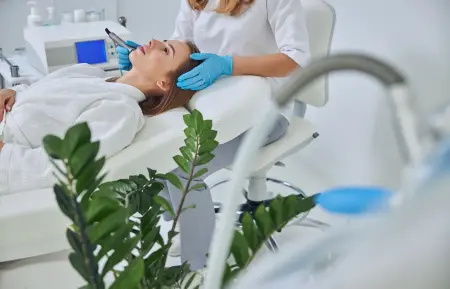GMC Registered Doctors
Expert Diagnosis & Care
Dermoscopy Assessment
Accurate Mole Evaluation
Expert Clearing Options
Medical & Aesthetic Focus
CQC Regulated Clinic
Safe & Professional Environment
Understanding Moles: Definition, Types, and Development
Moles (medically known as naevi) are common skin growths that develop when pigment-producing cells called melanocytes cluster together on the skin. These natural skin features vary widely in appearance—from flat to raised, smooth to rough, and range in colour from pink to dark brown or black. Most people have between 10-40 moles on their bodies by adulthood.
At Revitalise London, our GMC registered doctors provide expert assessment and information about moles and clearing options. Our CQC-regulated Harley Street clinic delivers comprehensive care with a focus on both skin health and aesthetic considerations.
Types of Moles: Understanding the Different Varieties
Medical dermatology recognises several distinct types of moles:
- Common Moles (Acquired Naevi): Develop during childhood/early adulthood, small (5-6mm), round, well-defined borders, consistent pink to dark brown colour.
- Congenital Naevi: Present at birth or within first year. Vary in size; larger ones benefit from regular monitoring.
- Dysplastic Naevi (Atypical Moles): Larger (>6mm), irregular borders, variable colouration (tan/brown/black/pink). Recommend regular professional evaluation.
- Spitz Naevi: Typically pink, raised growths, most common in children/adolescents. Warrant careful assessment.
Our GMC registered doctors provide comprehensive evaluations for accurate identification.
The Science Behind Moles: How and Why They Develop
Understanding how moles form helps monitor skin health:
Mole Formation:
Moles form when melanocytes (pigment cells) grow in clusters instead of spreading evenly, producing the mole’s pigment.
Influencing Factors:
- Genetic Predisposition: Family history impacts mole number and appearance.
- Sun Exposure: UV radiation can increase mole numbers and potentially alter appearance.
- Hormonal Changes: Puberty, pregnancy, menopause can influence development.
- Age: Most moles develop in childhood/early adulthood; new moles slow after age 30.
Moles follow a natural progression:
- Development: Mostly appear in first two decades.
- Maturation: May become more raised and lighter over time.
- Stabilisation: Most maintain consistent appearance in adulthood.
- Fading: Some may fade or disappear in older age.
Our doctors provide personalised information on mole development.
Monitoring Your Moles: The ABCDE Method
Regular self-examination is important. Follow the evidence-based ABCDE criteria:
- A – Asymmetry: One half doesn’t match the other.
- B – Border: Irregular, notched, or blurred edges.
- C – Colour: Multiple colours or uneven pigment distribution.
- D – Diameter: Larger than 6mm (pencil eraser size), especially if new or changed.
- E – Evolution: Any change in size, shape, colour, elevation, or new symptoms (itching, bleeding, crusting).
Also be attentive to:
- New moles appearing after age 30.
- Moles looking different from others (the “ugly duckling” sign).
- Rapid changes over weeks/months.
Prompt medical evaluation is needed for any concerning changes. Our GMC registered doctors use advanced techniques for accurate assessment.
Why Consider Mole Clearing? Medical and Aesthetic Factors
Consultation with our GMC registered doctors helps determine if clearing is appropriate:
Medical Considerations
- Concerning Features: Moles with ABCDE changes may require clearing for microscopic examination (histopathology).
- Recurrent Irritation: Moles frequently rubbed by clothing, shaving, or jewellery causing discomfort or bleeding.
- Functional Interference: Large moles impacting movement or vision.
Aesthetic Considerations
While cosmetic clearing is common, we ensure:
- Thorough assessment before cosmetic clearing.
- Appropriate techniques chosen to minimise marking.
- Histopathology arranged when medically indicated.
Our CQC-regulated practice upholds high clinical standards while respecting patient preferences.
Professional Mole Assessment: What to Expect
Our comprehensive assessments by GMC registered doctors include:
A thorough discussion and examination covering:
- Detailed medical history (family history of skin conditions).
- Discussion of any changes noticed in moles.
- Comprehensive full-body skin examination.
- Dermoscopic evaluation of moles.
- Documentation of mole characteristics and locations.
- Photographic mapping if appropriate (for tracking changes).
Our doctors utilise specialised techniques:
- Visual Examination: Identifying subtle features.
- Dermoscopy: Magnified, polarised light view of subsurface structures for detailed diagnosis.
- Digital Mole Mapping: Tracking numerous or atypical moles over time with high-resolution photos.
- Comparative Assessment: Identifying “ugly duckling” moles that stand out.
Based on your assessment, we may recommend:
- Regular self-monitoring using ABCDE criteria.
- Scheduled professional follow-up checks (e.g., annually).
- Clearing of concerning moles for histological analysis.
- Referral for specialised care if needed.
We prioritise patient education for effective self-monitoring.
Mole Clearing: Common Questions Answered
Information on timing, techniques, and recovery:
When is the Best Time to Consider Mole Clearing?
- Medical Necessity: Promptly, if a mole shows concerning changes.
- Comfort/Function: Anytime, if a mole causes persistent irritation or interferes with activities.
- Cosmetic Reasons: Often preferred during cooler months for easier sun protection during healing.
What Techniques Are Used for Professional Mole Clearing?
Various techniques exist (e.g., precision removal), chosen based on mole type, location, and reason for clearing. All procedures are performed by our GMC registered doctors.
Will There Be a Mark After Mole Clearing?
Any clearing procedure leaves a mark, but our doctors use techniques to minimise scarring. The final appearance depends on mole size/depth, technique, location, individual healing, and aftercare. Realistic expectations are discussed during consultation.
How Long is the Recovery Period?
Recovery varies but generally:
- Return to normal activities quickly (often same day).
- Healing progresses over 1-4 weeks.
- Detailed aftercare instructions are provided.
- Sun protection of the site is crucial during healing.
The Importance of Professional Mole Assessment and Clearing
Why consulting GMC registered doctors is essential:
Benefits of Seeking GMC Registered Doctors
- Accurate diagnosis of mole type and risk assessment.
- Comprehensive evaluation considering your overall skin health.
- Selection of the most appropriate clearing technique.
- Histological examination of tissue cleared when medically necessary.
- Proper medical documentation for future reference.
- Peace of mind from expert evaluation.
Limitations of Non-Professional Approaches
- Inability to accurately diagnose or assess risk.
- Risk of incomplete clearing, microbial issues, or excessive scarring.
- Lack of necessary pathological examination.
- Absence of proper medical records.
Our doctors can discuss these advantages further during your consultation.
Why Choose Revitalise London for Mole Assessment and Clearing?
Providing expert dermatological care in a professional, regulated environment.
Dedicated Expertise and Patient-Centred Care
Choosing the right clinic for mole assessment and clearing is vital for your skin health and peace of mind. At Revitalise London, we prioritise accurate diagnosis, safe procedures, and excellent aesthetic outcomes.
Exceptional Medical Expertise
Our GMC registered doctors and board-certified dermatologists specialise in mole assessment (dermoscopy) and clearing techniques, ensuring the highest standard of care.
CQC Regulated Clinic
We operate under strict CQC regulations, guaranteeing a safe, clean, and professionally managed environment for all procedures.
Advanced Diagnostic Tools
We utilise high-quality dermoscopy and potentially digital mapping to accurately assess moles and track changes over time.
Patient-Centred Approach
We ensure unhurried consultations, clear explanations of findings and options, shared decision-making, and comprehensive aftercare support.

Frequently Asked Questions About Moles and Their Management
Answers to common queries about moles.
Most adults have 10-40 moles. The number varies greatly and is less important than monitoring individual moles for changes using the ABCDE rule.
Start regular self-monitoring in early adulthood. Parents should monitor children’s moles, especially large or unusual congenital ones. Continue monitoring throughout life.
Monthly self-examination is recommended. Professional skin checks are typically advised annually, or more frequently if you have risk factors (e.g., many moles, atypical moles, family history). Follow your doctor’s advice.
Yes, UV radiation can increase the number of moles and potentially cause changes in existing ones, increasing risk. Consistent sun protection is important for skin health and mole management.
Yes, genetics play a significant role in the number, type, and distribution of moles. Family members often share similar mole patterns.
Hormonal changes during pregnancy can sometimes cause existing moles to darken or slightly enlarge. While usually benign, any significant or rapid changes should always be evaluated by a doctor.






